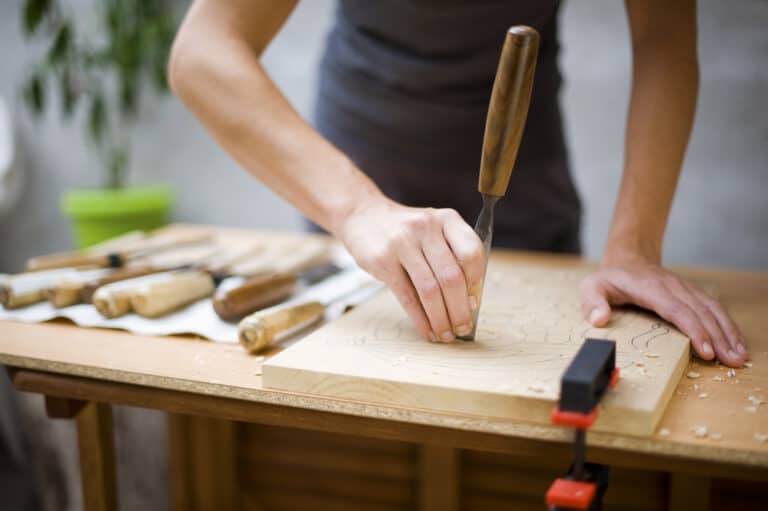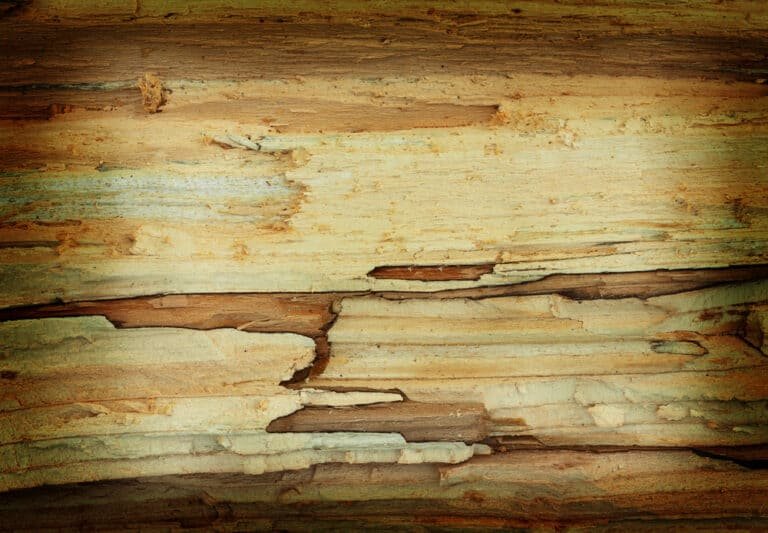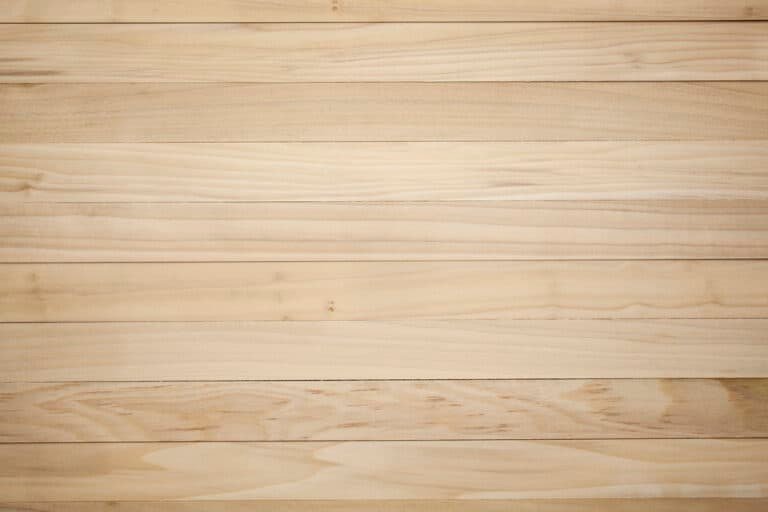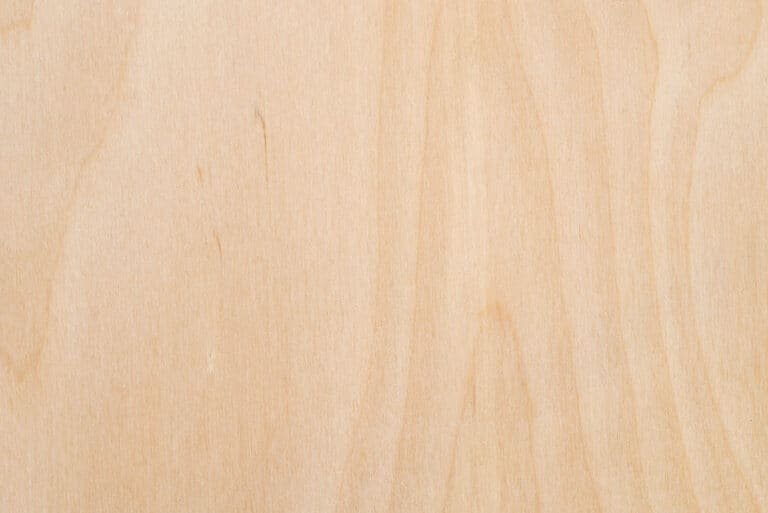Oak is good for carving. Oak is a durable and strong hardwood that is ideal for big projects like furniture and sculptures. However, carving Oak is difficult due to its hardness, so I only recommend it for advanced wood carvers. Oak is not a good wood for beginners to learn on.
| Pros of Oak | Cons of Oak |
|---|---|
| Durable and Long-Lasting | Difficult to Carve |
| Beautiful Grain Patterns | Increased Tool Wear |
| Versatile for Various Projects | Risk of Splitting |
| Readily Available | Heavy and Dense |
| Takes Stain Well | Porous Texture |
| Safe and Non-Toxic | Potential for Tannin Stains |
| Can be Expensive |
Pros of Carving with Oak Wood:
- Durability: Oak is a hardwood, it is very strong and durable. Carvings made from oak are likely to last a long time.
- Attractive Grain: Oak has a beautiful and pronounced grain pattern, resulting in some breathtaking work.
- Versatility: Oak can be used for a wide variety of carving projects, from intricate detailed work to larger, more robust pieces.
- Availability: Oak is relatively easy to find and purchase.
- Takes Stain Well: Oak absorbs stain evenly, allowing you to achieve a consistent and appealing finish on your carved pieces.
- Safe and Non-Toxic: Oak wood is non-toxic and food-safe. This makes it a great option for creating kitchen utensils, baby toys, and other items that require a safe material.
Cons of Carving with Oak Wood:
- Hardness: Makes the wood more difficult to carve, especially for beginners.
- Tool Wear: The hardness of oak can lead to increased wear and tear on your carving tools, requiring more frequent sharpening and potentially shorter tool life.
- Risk of Splitting: Oak can split, especially if it is not properly dried and seasoned. This can make it challenging to work with and may result in wasted material.
- Heavy and Dense: Oak is a very heavy and dense wood, which can make it more challenging to handle and work with, especially for larger projects.
- Porous Texture: Oak’s porous texture can sometimes make it difficult to achieve a smooth finish, requiring extra sanding and finishing work.
- Potential for Tannin Stains: Oak contains tannins, which can react with certain finishes and adhesives, potentially causing staining or discoloration.
- Cost: Depending on where you are located, oak can be more expensive than other carving woods, which might be a consideration if you are working on a budget.
Tips for Carving Oak Wood
1. Use Sharp Tools:
- Maintain Sharpness: Oak’s hardness can dull tools quickly, so ensure your chisels, gouges, and knives are razor-sharp before starting.
- Regular Sharpening: Be prepared to sharpen your tools frequently during the carving process to maintain precision and ease of carving.
2. Start with a Simple Design:
- Build Skills Gradually: If you’re new to carving oak, start with a simple design to build your skills and understand how the wood behaves.
- Practice on Scrap Pieces: Before diving into your main project, practice on scrap pieces of oak to get a feel for the wood.
3. Take Your Time:
- Be Patient: Oak’s density means that carving will take more time and effort. Be patient and avoid rushing to prevent mistakes and injuries.
- Controlled Strokes: Use controlled and deliberate strokes, paying close attention to the grain direction to avoid tear-out.
4. Pay Attention to Grain Direction:
- Study the Grain: Before starting, study the wood’s grain pattern to plan your carving strokes.
- Carve With the Grain: Whenever possible, carve with the grain to achieve smoother cuts and reduce the risk of chipping.
5. Leverage Mallet Work:
- For roughing out and removing large amounts of Oak, use a mallet and chisels.
- Refine with Hand Tools: Switch to hand tools for detailed work and finishing touches.
6. Sand and Finish Properly:
- Smooth the Surface: Due to oak’s porous nature, thorough sanding is essential to achieve a smooth surface.
- Seal the Wood: Use a suitable finish to seal the wood and highlight the grain. Oak takes stain well, but ensure any finish used is compatible with oak to prevent tannin stains.
7. Ensure Proper Safety:
- Wear Safety Gear: Use gloves to protect your hands and safety goggles to protect your eyes from wood chips.
- Work in a Well-Ventilated Area: Ensure your workspace is well-ventilated, especially if you’re using finishes or adhesives.
8. Embrace the Learning Curve:
- Learn from Mistakes: Don’t get discouraged by mistakes; learn from them and use them to improve your skills.
- Practice Regularly: The more you work with oak, the more familiar you’ll become with its properties, making it easier to carve over time.
Oak Carving Projects
These projects showcase the versatility, strength, and beauty of oak, making the most of its unique characteristics.
1. Furniture
- Dining Tables and Chairs: Oak’s strength and durability make it an excellent choice for dining room furniture.
- Coffee Tables: A solid oak coffee table can be both functional and a beautiful centerpiece in a living room.
- Bookshelves: Oak bookshelves are sturdy and can hold a lot of weight, making them perfect for libraries or home offices.
2. Decorative Carvings
- Wall Art: Create intricate wall hangings or relief carvings to showcase oak’s beautiful grain patterns.
- Sculptures: Oak’s durability allows for both small and large sculptures that can last for generations.
3. Kitchenware
- Cutting Boards: Oak’s density makes for durable cutting boards, though it’s important to ensure the oak is properly sealed and maintained.
- Utensils: Carve spoons, spatulas, or salad servers from oak for kitchen tools that are both functional and beautiful.
4. Outdoor Projects
- Garden Benches: Oak’s resistance to wear makes it a good choice for outdoor furniture like benches or picnic tables.
- Birdhouses: Create durable birdhouses that can withstand the elements.
5. Boxes and Containers
- Jewelry Boxes: Carve and assemble a jewelry box with intricate details to showcase the oak’s grain.
- Storage Boxes: Create practical yet attractive storage solutions for various household items.
6. Frames
- Picture Frames: A carved oak picture frame can add a touch of elegance and durability to protect your cherished photos.
- Mirror Frames: Similarly, a mirror framed in carved oak can serve as a durable and attractive addition to any room.
7. Musical Instruments
- Stringed Instrument Bodies: Oak can be used for the bodies of guitars, violins, and other stringed instruments, though it’s less common than other woods like spruce or maple.
8. Architectural Elements
- Moldings and Trim: Use oak for carved moldings or trim to add a touch of elegance to a home’s interior.
- Staircase Railings: A carved oak staircase railing can be both a functional and artistic element in a home.
9. Personal Accessories
- Walking Sticks: Carve a sturdy and decorative walking stick or cane from oak.
- Keychains: Small, carved oak keychains can be a fun and personal project.
10. Games and Puzzles
- Chess Sets: Create a chess set with oak pieces for a game that’s as much a work of art as it is fun to play.
- Puzzle Boxes: Craft intricate puzzle boxes from oak for a challenging and rewarding project.
Woods That are Easier to Carve than Oak
There’s nothing shameful about starting with a softer wood. In fact, a lot of experts prefer softer woods to work with for their texture, color, and grain structure. Each wood is different, so start off with one that blends being beginner-friendly with a beautiful look.
Basswood
Basswood is a go-to for beginners. It’s one of the most easily workable woods out there, and controlling the outcome of a project is a breeze with this softwood. Readily available and inexpensive, basswood works well with both power and hand tools.
Aspen
Aspen is a great starter wood since it is soft yet strong. It has a beautiful straight grain and doesn’t split easily. This wood isn’t suitable for power tools since it does tend to fuzz, but if you’re a hand carver, then this wood is a beauty.
White Pine
White pine is easy to carve since it is not resinous and doesn’t have hard knots to work around. Soft and durable, white pine is easily available and cheap. The creamy color and smooth grain structure make this wood great for starter projects.
Alder
Alder is the softest among the hardwoods. Pliable and beautifully colored, alder is a little closer to the immediate side, but its structure is very forgiving and doesn’t fuzz a lot.
While not recommended for whittling, alder can be used for a variety of projects and with a variety of tools.
Butternut
A member of the Walnut family, butternut is a soft, light-colored wood that works well for power carving. The beautiful color and grain structure of Butternut made it highly sought after by woodcarvers. It is, however, usually more expensive than other types of wood, so butternut might be a better pick once you have some experience working with wood carvings.
Do You Have Experience Carving Oak?
Please leave any thoughts, tips or experiences you have carving Oak in the comments section below. Lets all pool our knowledge to help others, especially those new beginner wood carvers coming through.





